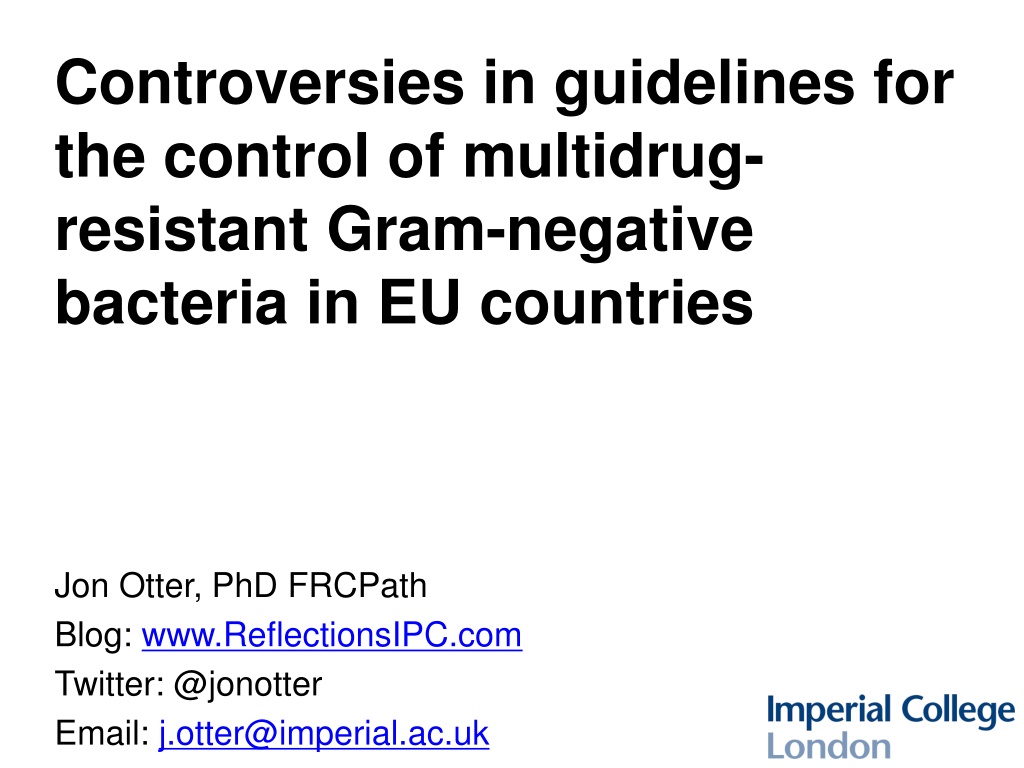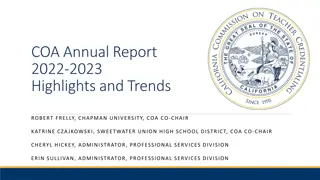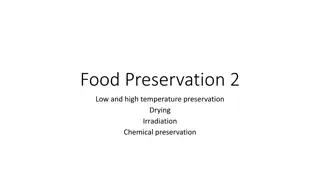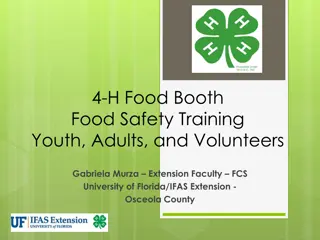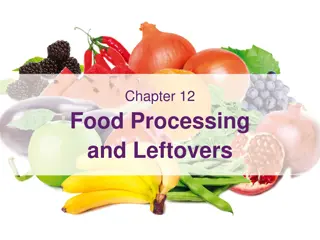Blanching and Steaming in Food Preparation
Blanching and steaming are essential techniques in food preparation. Blanching involves briefly boiling food then shocking it in cold water to halt cooking, while steaming cooks food in steam without submerging it in water. These methods preserve nutrients, enhance flavors, and are popular for vegetable preparation. Both techniques are preferred for their ability to retain the nutritional value and flavor of food items.
Download Presentation

Please find below an Image/Link to download the presentation.
The content on the website is provided AS IS for your information and personal use only. It may not be sold, licensed, or shared on other websites without obtaining consent from the author.If you encounter any issues during the download, it is possible that the publisher has removed the file from their server.
You are allowed to download the files provided on this website for personal or commercial use, subject to the condition that they are used lawfully. All files are the property of their respective owners.
The content on the website is provided AS IS for your information and personal use only. It may not be sold, licensed, or shared on other websites without obtaining consent from the author.
E N D
Presentation Transcript
Controversies in guidelines for the control of multidrug- resistant Gram-negative bacteria in EU countries Jon Otter, PhD FRCPath Blog: www.ReflectionsIPC.com Twitter: @jonotter Email: j.otter@imperial.ac.uk
Rising threat from MDR-GNB % of all HAI caused by GNRs. % of ICU HAI caused by GNRs. Acinetobacter baumannii Pseudomonas aeruginosa Stenotrophomonas maltophilia Klebsiella pneumoniae Escherichia coli Enterobacter cloacae Non-fermenters CPO Enterobacteriaceae CPE Hidron et al. Infect Control Hosp Epidemiol 2008;29:966-1011. Peleg & Hooper. N Engl J Med 2010;362:1804-1813.
Enterobacteriaceae vs. non-fermenters Share Gram stain reaction Concerning AMR Differ Risk factors & at-risk population Potential for epidemic spread Infection profile & mortality Prevalence Colonisation site & duration Transmission routes Resistance profile & mechanisms
Acronym minefield CPC MDR-GNR CPE CRO MDR-GNB ESBL CRC CRE CPE CRAB KPC
Patient placement Risk assessment Resp hygiene Linens Care equipment BBF spillage BBF exposure prevention & management Safe Injection practices Safe lumbar Puncture practices Resuscitation safety Care environment Hand hygiene PPE Waste disposal Safe use and disposal of sharps Asepsis: optimal use of invasive devices; PVC, CVC, UC Health Protection Scotland: http://www.documents.hps.scot.nhs.uk/hai/infection-control/ic-manual/ipcm-p-v2-3.pdf Centres for Disease Control: http://www.cdc.gov/HAI/settings/outpatient/outpatient-care-gl-standared-precautions.html UK Epic3: http://www.sciencedirect.com/science/article/pii/S0195670113600122 WHO: www.who.int/csr/resources/publications/EPR_AM2_E7.pdf
Risk factors & at-risk population Enterobacteriaceae LOS ICU stay Catheters / devices Ventilation Prior antibiotics Travel Patients in acute settings, particularly those with recent travel to areas of high prevalence. Potential for community spread. Non-fermenters LOS ICU stay Catheters / devices Ventilation Prior antibiotics Trauma (esp. burns) Risk factors At-risk population High-risk patients in the ICU and burns units; rare cause of community-acquired infection. ECDC CPE risk assessment, 2011. Peleg et al. Clin Microbiol Rev 2008;21:538-582.
Sites of colonisation 103 CRAB patients 80% tracheal aspirate 69% sternal skin 25% urine 69% rectal Apisarnthanarak et al. Clin Infect Dis 2013;56:1057-1059.
Who do I screen? UK PHE CPE Toolkit screening triggers: a) an inpatient in a hospital abroad, or b) an inpatient in a UK hospital which has problems with spread of CPE (if known), or c) a previously positive case. Also consider screening admissions to high- risk units such as ICU, and patients who live overseas.
How do I screen? Rectal swab is the best sample Insert no more than 2cm into rectum Twist gently and withdraw Ideally want to see faeces on swab. Patient and staff education as to why this is needed in order to overcome taboos Alternate specimen is stool sample, but have to wait for the patient to go
Can I swab your rectum please? Factors associated with patients declining to provide a rectal swab were: younger age (odds ratio (OR) 0.99, 95% confidence interval (CI) 0.99-1.00) female gender (OR 1.26, CI 1.04-1.52), transfers from other hospitals (OR 1.77, CI 1.07-2.93) or an unknown admission route (OR 1.61, CI 1.09-2.37), admission before the change in study description (OR 0.39, CI 0.31-0.48) the staff member who consented the patient (p<0.001); ethnicity was not a significant factor. Dyakova et al. Clin Microbiol Infect 2017 in press.
Improving screening compliance Dyakova et al. Clin Microbiol Infect 2017 in press.
Distant large problems vs. small local ones? CRE introductions come from hospitals within a regional referral network, even if the prevalence in another referral network is much higher (more than 100x higher, in fact)! Donker et al. BMC Med 2017.
Does screening and isolation work? All MDROs MRSA VRE ESBLs Baseline trend Hygiene intervention step-change Hygiene intervention trend change Screening step-change Screening trend change Rapid vs. conventional step-change Rapid vs. conventional trend-change Derde et al. Lancet Infect Dis 2014;14:31-39.
Hand hygiene 40% Median hand hygiene compliance from 95 studies. Erasmus et al. Infect Control Hosp Epidemiol 2010;31:283-294.
The bed location lottery Mitchell et al. J Hosp Infect 2015;91:211-217.
Surface survival 7 6 5 C. difficile Log (10) cfu / disc 4 Acinetobacter 3 K. pneumoniae 2 1 0 0 1 2 3 4 5 Time / weeks Otter & French. J Clin Microbiol 2009;47:205-207.
Surface survival strain variation 8 7 6 Log (10) cfu / disc 5 Klebsiella pneumoniae NCTC 9633 4 K. pneumoniae K2 3 K. pneumoniae K41 2 1 0 0 2 4 Time / weeks Otter & French. J Clin Microbiol 2009;47:205-207.
K. pneumoniae vs. E. coli Conclusion K. pneumoniae seems to be more environmental than E. coli.1,2 Surface contamination on five standardized sites surrounding patients with ESBL- producing Klebsiella spp. (n=48) or ESBL-producing E. coli (n=46).1 P<0.001 35 Risk factors for ESBL-E contamination = ESBL- KP, urinary catheter; carbapenem therapy was protective.3 30 25 Klebsiella spp. E. coli % contaminated 20 15 P<0.001 10 5 0 Rooms contaminated Sites contaminated 1. Guet-Revillet et al. Am J Infect Control 2012;40:845-848. 2. Gbaguidi-Haore. Am J Infect Cont 2013;41:664-665. 3. Freeman et al. Antimicrob Resist Infect Control 2014;3:5.
Persistent contamination 14 % sites contaminated with A. baumannii % sites contaminated with MRSA 12 % sites contaminated 10 8 140 samples from 9 rooms after 2xbleach 5705 samples from 312 rooms after 4xbleach 2680 sites from 134 rooms after HP vapor 6 4 2 0 Bioquell HP vapor decon 2 x bleach disinfection 4 x bleach disinfection 26.6% of rooms remained contaminated with either MRSA or A. baumannii following 4 rounds of bleach disinfection Manian et al. Infect Control Hosp Epidemiol 2011;32:667-672.
Enterobacteriaceae less environmental 9 8 7 6 Odds ratio 5 4 3 2 1 0 Nseir A.baumannii Nseir P.aeruginosa Nseir ESBL Ajao ESBL Nseir et al. Clin Microbiol Infect 2011;17:1201-1208. Ajao et al. Infect Control Hosp Epidemiol 2013;34:453-458.
MDR-GNR cleaning & disinfection checklist Clean / declutter Monitor cleaning process (e.g. fluorescent markers) Enhanced daily disinfection using bleach All equipment disinfected before leaving room Terminal disinfection using bleach or, ideally, H2O2 vapor or UV1-3 1. Gopinath et al. Infect Control Hosp Epidemiol 2013;34:99-100. 2. Snitkin et al. Sci Transl Med 2012;4:148ra116. 3. Verma et al. J Infect Prevent 2013;7:S37.
Contaminated sinks / drains CPE (K. pneumoniae) acquisition and clinical infection halved through improved management of sinks (OR = 0.51 for acquisions, and 0.29 for clinical cultures) (n=~7,500 pts). Mathers et al. Clin Infect Dis 2018 in press.
Carbapenem use, Europe ECDC point prevalence survey 2013.
Can we forecast a CPE storm? Could we find and implement an alert level of carbapenem use? The authors claim a stewardship intervention brought the CPE outbreak under control but also implemented case isolation, screening of contacts, barrier nursing and other infection control interventions . Study focussed only on OXA-48 K. pneumoniae; what about other Enterobacteriaceae and non-fermenters. What drives carbapenem resistance? The use of meropenem in the previous year plotted against the incidence rate of OXA-48-producing K. pneumoniae Gharbi et al. Int J Antimicrob Agents 2015 in press.
Antimicrobial stewardship impact Evaluating impact of 6 month antimicrobial stewardship intervention on an ICU by comparing bacterial resistance for matched 6 month periods either side of intervention. 100 90 80 % isolates resistant 70 ** 60 Amikacin Gentamicin Ciprofloxacin Ceftazimime Imipenem 50 * *** 40 30 20 10 0 Before After Before After Before After Enterobacteriaceae Non-fermenters Gram-positive cocci Hou et al. PLoS ONE 2014;9:e101447; * = significant difference before vs. after.
Selective digestive decontamination 20 CRE colonized patients in each arm given gentamicin + polymyxin (SDD arm) or placebo (Control arm) 100 Percentage of CRE positive 80 rectal samples 60 SDD Control 40 20 0 0 9 days 2 weeks 4 weeks 6 weeks Saidel-Odes et al. Infect Control Hosp Epidemiol 2012;33:14-19.
Decolonisation using FMT 39 ESBL or CPE colonized patients randomised to oral abx + FMT (brown(!) line) or no intervention (blue line) Huttner et al. Clin Microbiol Infect 2019.
The panel does not recommend routine decolonization of CRE. Evidence is insufficient to provide a recommendation for or against decolonization of carbapenem- resistant A. baumannii. Tacconelli et al. Clin Microbiol Infect 2019.
Chlorhexidine efficacy Impact of chlorhexidine gluconate (CHG) daily bathing on skin colonization with KPC-producing K. pneumoniae in 64 long-term acute care patients. 60 % patients with CRE colonization 50 at one or more sites 40 30 20 10 0 Before CHG After CHG Lin et al. Infect Control Hosp Epidemiol 2014; 35:440-442.
Chlorhexidine reduced susceptibility Proportion of BSI isolates with reduced susceptibility to chlorhexidine on units using chlorhexidine gluconate (CHG) daily bathing (n=28) or not (n=94). 100 % isolates with reduced 80 CHG susceptibility 33% (p=0.028) 60 40 20 0 CHG Non CHG Suwantarat et al. Infect Control Hosp Epidemiol 2014;35:1183-1186.
Deisolation? N pts Duration of colonization Author Year Setting Organism Elderly care facilities, Scotland Long term care facility, USA Paediatric hospital, France Long term care facility, USA Patients discharged from hospital, Israel Mean 160 days (range 7-548) Median 77 days (range 47-189) Median 132 days (range 65-228) Median 144 days (range 41 349) Bird1 1998 38 ESBL K. pneumoniae Resistant Gram- negative rods ESBL Enterobacteriaceae Resistant Gram- negative rods Pacio2 2003 8 Zahar3 2010 62 O'Fallon4 2009 33 Zimmerman5 2013 97 CRE Mean 387 days 1. Bird et al. J Hosp Infect 1998;40:243-247. 2. Pacio et al. Infect Control Hosp Epidemiol 2003;24:246-250. 3. Zahar et al.J Hosp Infect 2010;75:76-78. 4. O'Fallon et al.Clin Infect Dis 2009;48:1375-1381. 5. Zimmerman et al.Am J Infect Control 2013;41:190-194.
Colonised staff? Decker et al. Clin Microbiol Infect 2018;24:82.e1-82.e4.
Which do you consider to be the most important measure to prevent transmission? 60 50 Antibiotic-resistant Enterobacteriaceae Antibiotic-resistant non- fermenters % respondents 40 30 20 10 0 Active Contact precautions (no active screening) Antibiotic stewardship Hand hygiene Cleaning / disinfection surveillance and contact precautions Data from around 150 webinar participants, mainly in the US, 2014.
What works? Israel * * Physical segregation of CRE carriers; cohorted staff; appointed taskforce. Schwaber et al. Clin Infect Dis 2011;52:848-855.
Key questions Which interventions work? Are they different for Enterobacteriaceae and non-fermenters? (Probably, given their epidemiology.) What is the prevalence of CPE? How much do we believe a single negative screen? What is the duration of colonisation? Do we need rapid molecular diagnostics? Are there decolonisation strategies other than (virtually non) selective decontamination using abx? 49
Summary 1. MDR-GNB are emerging worldwide and represent a unique threat. 2. CPE in particular combine resistance, virulence and the potential for rapid spread. 3. Prevalence in the US appears to be patchy, but increasing. 4. We do not yet know what is effective in terms of prevention and control, but screening and isolation of carriers seems prudent. 5. Diagnosis can be challenging, and relies on close liaison with the microbiology laboratory.
